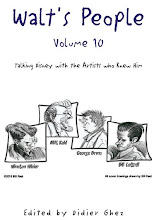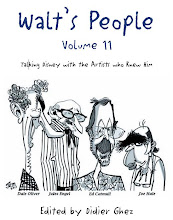This just in. Can anyone help?
[My name is Chelsea, and I am a Cinema and Animation student at Elon University. I am currently completing an Honors undergraduate thesis on the use of stereoscopic 3D in hand-drawn animation. As part of my research, I am looking into older methods of converting Disney-style animation into 3D, including Disney's own work in the field. I came across your Disney History blog while collecting articles, and was impressed by the depth and detail of your archive. At the moment, I am running into a roadblock in my search, and am hoping you can shine a light on where to look next for new information.
Specifically, I am trying to learn more about the short films Melody and Working for Peanuts, both released by Disney in 1953. While I know these films were both produced in 3D (Melody being the first 3D animated film ever), I'm having a hard time learning anything about the specific processes used to convert the 2D animation into a 3D viewing format. Most 3D history books focus on live-action 3D films, and I wouldn't know where to start looking in Disney short film research. As both 3D filmmaking and Disney history are not taught by my school, my professors are equally unsure of where to look for more information.
In your research, have you come across any references to the techniques used in the production of either of these films? Are there any books or DVD extras you would recommend? Or, are there any websites, archives, or other historians you would point to as a better source of insight? Any information about these films and their creative process would be a great boon to my research and final thesis paper.
Thank you very much for reading, and have a wonderful day!]

[My name is Chelsea, and I am a Cinema and Animation student at Elon University. I am currently completing an Honors undergraduate thesis on the use of stereoscopic 3D in hand-drawn animation. As part of my research, I am looking into older methods of converting Disney-style animation into 3D, including Disney's own work in the field. I came across your Disney History blog while collecting articles, and was impressed by the depth and detail of your archive. At the moment, I am running into a roadblock in my search, and am hoping you can shine a light on where to look next for new information.
Specifically, I am trying to learn more about the short films Melody and Working for Peanuts, both released by Disney in 1953. While I know these films were both produced in 3D (Melody being the first 3D animated film ever), I'm having a hard time learning anything about the specific processes used to convert the 2D animation into a 3D viewing format. Most 3D history books focus on live-action 3D films, and I wouldn't know where to start looking in Disney short film research. As both 3D filmmaking and Disney history are not taught by my school, my professors are equally unsure of where to look for more information.
In your research, have you come across any references to the techniques used in the production of either of these films? Are there any books or DVD extras you would recommend? Or, are there any websites, archives, or other historians you would point to as a better source of insight? Any information about these films and their creative process would be a great boon to my research and final thesis paper.
Thank you very much for reading, and have a wonderful day!]























3 comments:
I saw both films at Disney in the early sixties. Both "Melody" and "Working for Peanuts" were made in the fifties and utilized 3D technology. I'm no expert on the technology but the 3D effect was created in camera using an optical process. Bill Justice directed "Peanuts" and Ward Kimball and Nick Nichols directed "Melody." I'm sorry I don't have more in depth knowledge about the process Disney used.
Strictly speaking, "Melody" is only the first American 3D cartoon, as Halas and Batchelor in the UK made "The Owl and the Pussy-cat" in 3D - intended for showing at the 1951 Festival of Britain, it was released in 1952.
What especially suited the animated cartoon to 3D production was the nature of the animation rostrum camera.
North and South ('top' and 'bottom') of the picture area were registration pegbars that could be moved left or right, incrementally, at the turn of a screw.
This meant that sequences of animation could be slid left or right independent of the animation on the opposite set of pegs, and the background. The background could be taped down free of the pegs, so that both top and bottom animation cels could shift independently.
This had been developed to accommodate panning shots in 2D cartoons, but it meant that three layers of a scene could be shot with the pegs in one position, then shot again with the pegs re-aligned to create a stereoscopic displacement. This would give three levels of depth.
Many rostrum cameras had more than two panning bars - some had 4, 2 at the top and 2 at the bottom, and some even 6 (3 and 3)! In addition the whole bench could also move. (In fact the bench could not only move North/South and East/West, but also rotate, not only enabling rotating shots but allowing the panning pegs to be set to a sloping angle, or vertically, for the duration of a shot. However, for the purposes of 3D we are only interested in East/West (left/right) displacement.
Shooting animation on the inner pegbar was time-consuming, as each cel had to be placed on the pegs, then taped to the bar and the registration pegs unscrewed, so that the cels on the outer pegs could lie flat over the inner bar (an inverse peg bar was devised later, where a thin peg strip plugged down into holes in the bar) but non-animating cels and background elements could be taped to the inner bars for multiple panning effects, or in the case of 3D more levels of background depth.
"Melody" was already completed when Walt Disney proposed a 3D version be shot. It was shot as planned for 2D projection, while the required degrees of off-setting were calculated for the 3D version. The 2D version was shot, as it were, centred. For the 3D both the left and right versions were shot at half the total displacement away from the centre, so that the overall layout remained central. I haven't seen the 3D version of "Melody" so I don't know if they redid any of the backgrounds, but for "Working for Peanuts", which was specifically designed to exploit the 3D process and can be seen on Youtube, flat colours were employed for the ground planes. This meant that although they actually remained vertical with the background 'horizon' there was no detail to stop the mind assuming the ground projected forwards to the foreground elements.
The animation has no depth to it other than what is implied by the three dimensional drawing, but this is quite powerful enough to fool the brain into assuming depth. When animated characters or objects are drawn getting larger or smaller (ie, closer or further away) the offset is progressively diminished or increased as appropriate.
Peter: A MILLION thanks for this. Could you email me at didier.ghez@gmail.com to tell me who you are? Thanks in advance.
Post a Comment